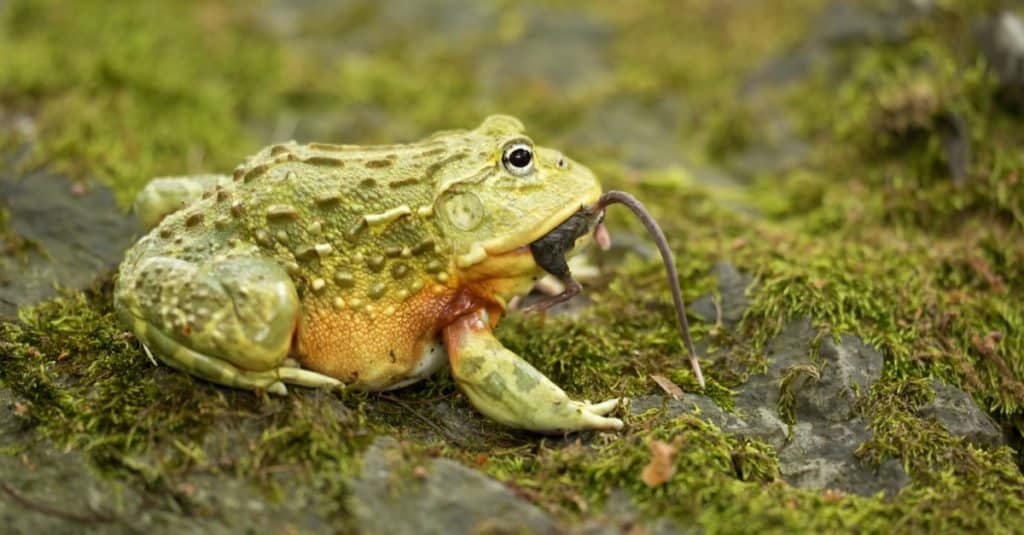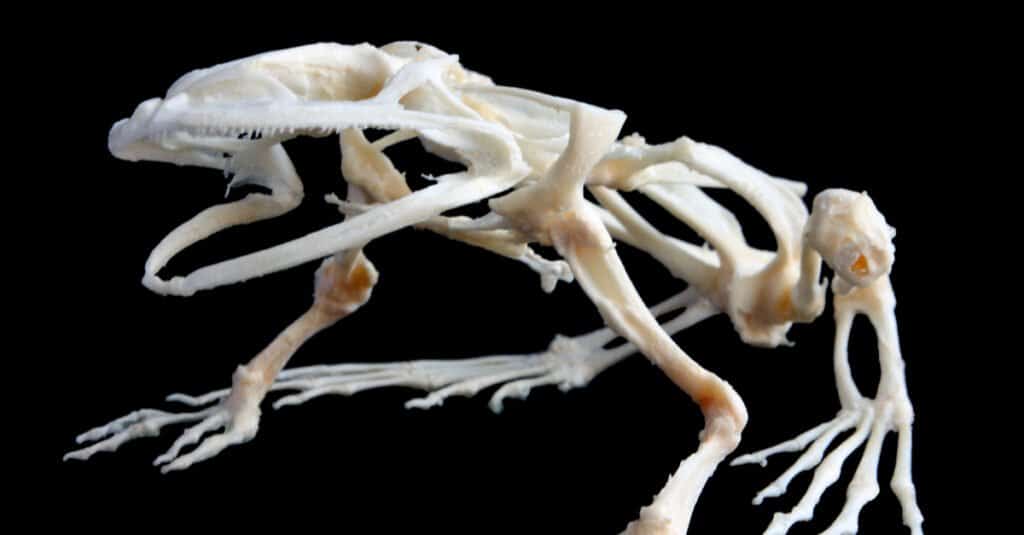African bullfrogs (Pyxicephalus adspersus) are the third largest frog species on the planet. They live across sub-Saharan Africa, and prefer areas where water is plentiful and fresh. These monster frogs can be found anywhere with slow moving water–like lakes, ponds, marshes, swamps, and sluggish streams. They’re recognizable by their large size (males are twice as large as females), yellowish-brown to green color, protuberant yellow eyes, and distinctive frog legs.
Here, we’ll take a deep dive into just what kind of armaments African bullfrogs keep in their mouths. We’ll learn more about how their distinctive teeth develop, and just what kinds of teeth they have. Then, we’ll analyze how they use their teeth to hunt, and why the African bullfrog’s teeth are different than those of many other frog species. Finally, we’ll touch on whether or not these gargantuan frogs are dangerous to humans.
Tadpole Teeth
Tadpoles are completely toothless at hatching time. They stay in their tadpole form for about three months, before tooth germs begin to form in their maxillae (upper jaws). As the tadpole grows into a frog, these tooth germs develop into larger and larger teeth.
African bullfrog tadpoles grow not only one, but three sets of teeth. The first two sets are replaced by the third and final set, which will stay with the tadpole for the rest of its life. Each set of teeth is more calcified–that is, harder and more toothlike–than the last.
As the tadpoles develop, they also grow other types of teeth, each one unique to frogs.
Adult African Bullfrog Teeth

African bullfrogs have three different types of ‘teeth’: vomerine teeth, odontoids, and maxillary teeth
©Stu Porter/Shutterstock.com
In their adult form, African bullfrogs have no tail. Males can get up to ten inches in length, and their lifespan in the wild may reach 30 years. That’s a long time to have teeth, and the African bullfrog has plenty of them. They not only have maxillary teeth along their top jaw, but vomerine teeth and structures called ‘odontoids’ as well.
Odontoids
One of the most easily recognizable features of an African bullfrog’s mouth is its odontoids–bony projections along the lower jaw. There are three odontoids, with one small one in the very center of the lower jaw, and two larger ones one either side. The odontoids are sharp, and can grow to fanglike proportions in larger frogs.
When African bullfrogs hunt, they actually roll their oversized tongues out over the odontoids. These strange fangs don’t usually come into play until after the frog has dragged the prey into its mouth.
Vomerine Teeth
The next ‘teeth’ in the African bullfrog’s mouth are the vomerine teeth. These are located at the top center of the mouth, towards the front. They are comprised of two flatter, bony projections. The vomerine teeth are common to frogs, and aid in the eating process. They’re not true teeth though.
Maxillary Teeth
The final teeth in the African bullfrog’s jaw are the maxillary (upper) teeth. These are perhaps the African bullfrog’s only true teeth; they line the upper jaws all the way around and are made of dentin and enamel. These teeth are relatively small, but are razor sharp and curve back towards the skull. They’re not generally visible when looking at an African bullfrog; it’s only when their upper lip is pulled back that they become visible. They may not be ostentatious, but they are deadly–much like the African bullfrog itself.
What Do African Bullfrogs Use Their Teeth For?

African bullfrogs use their teeth, tongues, and legs to hunt and eat prey
©Milan Zygmunt/Shutterstock.com
African bullfrogs are opportunistic carnivores. From the time they can swim, they eat anything that fits into their mouth. As adults, this includes fish, rodents, other amphibians (including smaller African bullfrogs), reptiles, insects, and even birds.
The African bullfrog hunts by propelling itself at prey with its extremely powerful back legs. Once close enough, it opens its mouth and hurls its tongue at the creature, pulling it back into its jaws. Once inside the bullfrog’s mouth, the odontoids keep the prey from escaping, and the sharp maxillary teeth imprison the creature within.
In the case of larger prey, like rodents or birds, African bullfrogs make use of their odontoids and maxillary teeth to position the animal headfirst into the mouth. Once in the clutches of the strong jaw and wicked teeth, the creature has little hope of escape, and soon suffocates.
Different From Other Frogs

A pond frog skeleton.
©photowind/Shutterstock.com
Many frogs have what’s called ‘pedicel’ teeth. These type of teeth are divided into three parts: the lower pedicel, the middle dividing zone, and the upper crown. This type of tooth structure is very unique in the animal kingdom. African bullfrogs, however, have non-pedicellate teeth. Their teeth are made up of dentin, with a small enamel tip on the crown, and lack the pedicel and dividing zone.
Are African Bullfrogs Dangerous to Humans?
African bullfrogs are considered exotic pets; they can’t be found in just any pet store. They are however prized by amphibian enthusiasts for their long lifespan (up to 35 years) and entertaining hunting abilities.
As pets, these carnivores sometimes come into contact with human flesh, and the results can be bloody. An African bullfrog won’t attack a human without provocation, especially if that human is keeping them well fed with small prey. But, if threatened or provoked, African bullfrogs will bite.
The biggest danger with one of these bites is to the fingers. The odontoids and maxillary teeth are designed to grip, and are therefore very sharp. Any contact with them usually pierces the skin, and causes bleeding. In severe cases, bites may require medical attention.
The photo featured at the top of this post is © Audrey Snider-Bell/Shutterstock.com
Thank you for reading! Have some feedback for us? Contact the AZ Animals editorial team.






